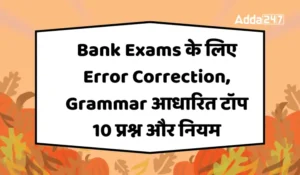English Language Section has given heebie-jeebies to the aspirants when they appear for a banking examination. As the level of every other section is only getting complex and convoluted, there is no doubt that this section, too, makes your blood run cold. The questions asked in this section are confusing and very time-consuming. But once dealt with proper strategy, speed, and accuracy, this section can get you the maximum marks in the examination.
Direction (1-15): In each of the questions given below a sentence is given which is then divided into five parts out of which one part is incorrect. You must choose the grammatically incorrect part as your answer.
Directions (1-10): Read the following passage carefully and answer the questions given below them. Certain words/phrases have been printed in bold to help you locate them while answering some of the questions.
This is an important year for making progress on the Paris Agreement (PA), which was discussed at the climate meeting called the Conference of Parties (COP-21) to the UN Framework Convention on Climate Change (UNFCCC) in December 2015. The Paris Agreement entered into force in November 2016. A two-week-long meeting was recently concluded in Bonn (April 30-May 10) where the operational guidelines for implementing the PA were to be discussed and agreed upon by all parties. What one was looking for was a common, consistent framework of how each country would define and measure its commitments. It would also include proposals for how action taken could be monitored, accounted for and kept transparent while providing some level of flexibility.
This meeting was the 48th session of the UNFCCC Subsidiary Body for Implementation (SBI) and Subsidiary Body for Scientific and Technological Advice (SBSTA), referred to as SB48. With insufficient progress towards goals, another interim meeting has been proposed in Bangkok ahead of COP-24 in Katowice, Poland, in December 2018. A good draft on the rulebook ought to be ready before the COP. Ideally, these guidelines should help countries develop ambitious targets for the next level of the Nationally Determined Contributions (NDCs). There should also be a regularised and dependable flow of funds from rich countries so that climate action can be implemented in developing nations. Countries can then develop along a path of sustainable development that is low carbon and inclusive of poor and other marginalised communities.
The roadblocks at the Bonn meeting seemed predictable. On the issue of the NDCs, the question was the scope of the rulebook. Developing countries want them to cover mitigation targets, adaptation and the means of implementation for the NDCs. Developed or rich countries would like the rulebook to be limited to mitigation, the reduction of greenhouse gases. But since most countries require adaptation programmes in a warming world and need support to implement their national targets, it is essential that these be included too. In fact, most NDCs require support for operationalising them. The “means of implementation” are about financial support and technology transfer to build capacity in poorer countries and have always been contentious. At various sessions and discussions on climate change, this issue has turned out to be a deal breaker.
At the Copenhagen summit, it was agreed that from 2020, rich countries would provide a minimum of $100 billion each year to poor and developing countries. There is little sign that these funds will be available. Instead, the discussion on finance has veered towards: how to increase the number of donors who will provide funds; which countries should perhaps be excluded from these funds; and whether these funds are a part of or distinct from the official development assistance, and so on. According to the principle of common but differentiated responsibilities of the UNFCCC, while actions need to be ambitious to limit warming, providing support is essential for equitable action.
The issues related to loss and damage (L&D) are another thorn in the negotiations. L&D is a means to provide assistance to poor countries that experience severe impacts from climate change but have contributed very little to the greenhouse gases responsible for the warming and its effects. This is a very important issue for the least developed countries and for small islands, which are already experiencing the brunt of sea level rise. But there was little progress on the funds that could be used to support L&D. Participants could not come to an agreement on any significant issue and thus have not produced a draft document to guide full implementation of the PA. Some commentators have said that the pace of the discussions was slow and that there was an absence of urgency.
The NDCs put forth prior to the Paris COP would lead up to 2030. Discussions on raising the bar beyond that would be discussed at COP-24 in Poland. Even if the current NDCs were implemented, the world would be on track to be warmer by about 3°Celsius.The discussions at Bangkok in early September are therefore crucial and continue the incomplete task from this Bonn meeting. The UN is also expected to release the report on the impacts from a 1.5°C warming around the same time. Given the growing frustration of experienced negotiators on all sides after more than two decades of intense climate talks, it appears that pressure from youth, especially in rich countries, is vital. Unless they remind governments and the public of the responsibilities of their countries towards mitigation, adaptation and support for means of implementation, keeping global warming under reasonably safe levels for humankind could be impossible.
Q1. What was the agenda of the recently concluded meeting in Bonn?
(a) To discuss R&D opportunities across the globe.
(b) To discuss the drawbacks of the Paris Agreement.
(c) To discuss the operational guidelines for implementing the Paris Agreement.
(d) To discuss infrastructure development programmes.
(e) All are correct
Sol. Refer 1st paragraph, 4th line.
Q2. Which of the following statements is/are incorrect in context with the passage?
(a) Developing countries wanted the rulebook to cover mitigation targets, adaptation, and the means of implementation for the NDCs.
(b) Developed countries wanted the rulebook to be limited to mitigation.
(c) Rich countries provided $100billion to each poor and developing countries.
(d) There was little progress on the funds that were to be used to support L&D.
(e) All are correct.
Show Answer
Sol. Refer 4th paragraph, 1st three lines.
Q3. As per the passage, what is the significance of Loss and Damage issue?
(a) It is a means to provide assistance to rich countries that experience severe impacts from climate change but contribute less to greenhouse gases.
(b) It is a means to provide assistance to poor countries that experience severe impacts from climate change and contribute a lot to greenhouse gases.
(c) It is a means to provide assistance to poor countries that experience severe impacts from climate change but contribute less to greenhouse gases.
(d) It is a means to provide assistance to rich countries that experience lesser impacts from climate change but contribute a lot to greenhouse gases.
(e) None of the above
Show Answer
Sol. Refer 5th paragraph, first four lines.
Q4. Which of the following is the most suitable title for the passage?
(a) Impacts of climate change
(b) Is the Paris Agreement Efficient?
(c) Is it possible to slow global warming?
(d) Developed v/s developing nations
(e) Roadblocks in implementing sustainable development
Sol. The most suitable title for the passage is “Is it possible to slow global warming?”. Though entire passage talks about the various summits and policy frameworks to mitigate the global warming but in last paragraph, author put forth a factual data that even after implementing certain measures, it is bit difficult to stop the further warming and leaves a food for thought.
Q5. Which of the following is/are correct in context with the passage?
(I) Most countries require adaptation programmes in a warming world and need support to implement their national targets.
(II) Even if the current NDCs were implemented, the world would be on track to be warmer by about 3°Celsius.
(III) Given the growing frustration of experienced negotiators on all sides after more than two decades of intense climate talks, it appears that pressure from youth, especially in rich countries, is vital.
(a) Only (I)
(b) Only (II)
(c) Only (III)
(d) Both (II) and (III)
(e) All are correct.
Sol. All are correct
Q6. Choose the word which best expresses the meaning of the following word given in bold in the passage
CONTENTIOUS
(a) Amiable
(b) Peaceful
(c) Belligerent
(d) Non- combative
(e) Pacific
Sol. Contentious: likely to cause disagreement or argument
Belligerent: inclined to or exhibiting assertiveness, hostility, or combativeness
Q7. Choose the word which best expresses the meaning of the following word given in bold in the passage
BRUNT
(a) Staple
(b) Adjunct
(c) Appendage
(d) Offshoot
(e) Aspect
Sol. Brunt: the main or greater part of something as distinguished from its subordinate parts
Staple: a main or important element of something.
Q8. Choose the word which best expresses the meaning of the following word given in bold in the passage
MITIGATE
(a) Injure
(b) Exacerbate
(c) Aggravate
(d) Assuage
(e) Heighten
Sol. Mitigate: make (something bad) less severe, serious, or painful.
Assuage: make (an unpleasant feeling) less intense
Q9. Choose the word which is most opposite to the following word given in bold in the passage
VEER
(a) Digress
(b) Avert
(c) Skid
(d) Straighten
(e) Swerve
Sol. Veer: change direction suddenly.
Q10. Choose the word which is most opposite to the following word given in bold in the passage
FRUSTRATION
(a) Aggravation
(b) Bugbear
(c) Exasperation
(d) Hassle
(e) Gratification
Sol. Frustration: the feeling of being upset or annoyed as a result of being unable to change or achieve something.
Gratification: pleasure, especially when gained from the satisfaction of a desire.
Directions (11-15): In the passage given below there are blanks which are to be filled with the options given below. Find out the appropriate pair of words in each case which can most suitably complete the sentence without altering the meaning of the statement.
Elections too are about numbers and are an exact exercise. But only until the sum is reached. That is, until the Election Commission finishes its (11)…………. and declares the ‘sum’. The Election Commission counts and then announces the counts, and once it has done that, (12)……………. After that has been done, the President in the case of Lok Sabha elections or the Governor in the case of Vidhan Sabha elections takes over. It is in their hands that the result of the counting converts itself into the pattern of seats in the elected House. The President or Governor then becomes the keeper of the sum’s (13)…………….. and has to see that the pattern of the sum is honored by the pattern of the seats. In other words, the architecture of the sum is (14)……………. by the architecture of their power. The keeper has to see that the integrity of that architecture is not garbled to create a house different in shape from the (15)…………… of the sum’s design
Q11.
(a) assumptions
(b) estimations
(c) calculations
(d) measurements
(e) analysis
Sol. calculations– the act of calculating
Q12.
(a) expires
(b) retires
(c) dies
(d) inspires
(e) impeaches
Sol. retires– to withdraw; to take away
Q13.
(a) concision
(b) precision
(c) purity
(d) simplicity
(e) integrity
Sol. purity– the state or degree of being pure
Q14.
(a) explained
(b) gained
(c) retained
(d) belonged
(e) sustained
Sol. retained– to keep in possession or use
Q15.
(a) blueprint
(b) plan
(c) print
(d) agenda
(e) scheme
Sol. blueprint- layout
You May also like to Read:






 Practice for English Section: 15 Cloze T...
Practice for English Section: 15 Cloze T...
 Bank Exams के लिए Error Correction, Gram...
Bank Exams के लिए Error Correction, Gram...
 English Quiz For NIACL AO Mains 2024 Exa...
English Quiz For NIACL AO Mains 2024 Exa...








